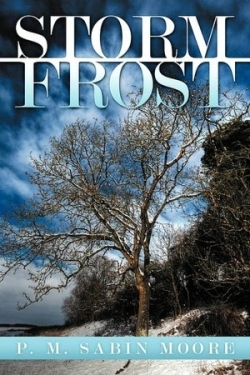Storm Frost
British author Pauline Sabin Moore’s historical romance, Storm Frost, will be more readily received by dedicated followers of British Anglo Saxon history and literature than by general readers looking for happily-ever-after love and romance. In some ways, this is a pity, because the storyline is a gripping saga of age-old conflicts between star-crossed lovers whose fatal flaws and circumstances beyond their control lead to disastrous consequences.
Using the recorded history of the end of the 6th Century and the literature of such epics as Wulf and Eadwacer, A Wife’s Lament and The Husband’s Message, Moore has fashioned her own version of the tale of King Raedwald, cuckolded by his older brother Wulfgrim (aka Wulf or Prince Eni), and Princess Niartha, the woman who unintentionally brings grief to Raedwald and island exile to Wulf. In fact, Princess Niartha vows to find Wulf, even as she is also exiled instead of being burned alive on her dead father’s pyre.
Despite the hardships she endures while living off the land, including beatings and a rape, she clings to her love for Wulf. Regrettably, she gives in to a moment of passion that seals her fate forever as an outcast. This adversely affects the lives of everyone around her, resulting in the deaths of friends and enemies alike.
In the end, however, reconciliations lead to happier times for her and her kin despite foreshadowings of darker days ahead in the future story Moore has more recently published.
Moore’s formal studies of Old English literature and her experiences as a National Trust Volunteer and a Sutton Hoo Guide have steeped her in the history that pervades her novel. Her references to the customs of the times are convincing as she describes feasts and foods and superstitions and “a poultice of mugwort, plantain, and fennel,” and “a tisane of mayweed and nettles” used for medicinal purposes.
She slips, however, in a referring to Niartha as a “slut,” since the OED and other authorities claim the word was not in use until much later than the time of Moore’s story. A handful of typos also mars the narrative, while the unaccustomed—although historically accurate—spellings of the names of characters and geographic places can be stumbling blocks for readers lacking the contextual history of the novel’s settings.
Those willing to stay with it, however, will find Storm Frost a rewarding read of back stories intermingled with Niartha’s narratives, Wulf’s brief laments, and third-person accounts of the adventures of the other characters.
It is also worth noting the outstanding cover art. Richard Moore’s photograph depicts the “ancient, twisted yew tree” hiding the cave that shelters Niartha from the storm frost of the winter with “its roots snaking down into the earth like the warped fingers of an old woman.”
In all, a commendable effort.
Reviewed by
M. Wayne Cunningham
Disclosure: This article is not an endorsement, but a review. The publisher of this book provided free copies of the book and paid a small fee to have their book reviewed by a professional reviewer. Foreword Reviews and Clarion Reviews make no guarantee that the publisher will receive a positive review. Foreword Magazine, Inc. is disclosing this in accordance with the Federal Trade Commission’s 16 CFR, Part 255.

